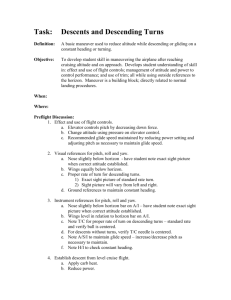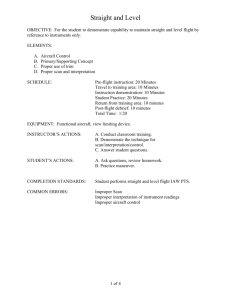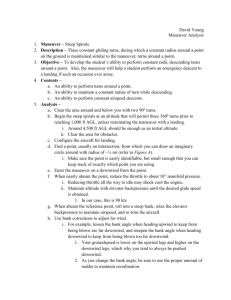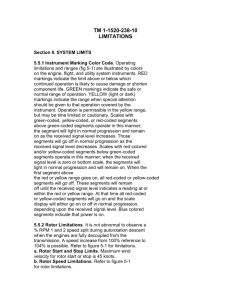Ex 6 Straight & Level Flight Aim To attain and
advertisement
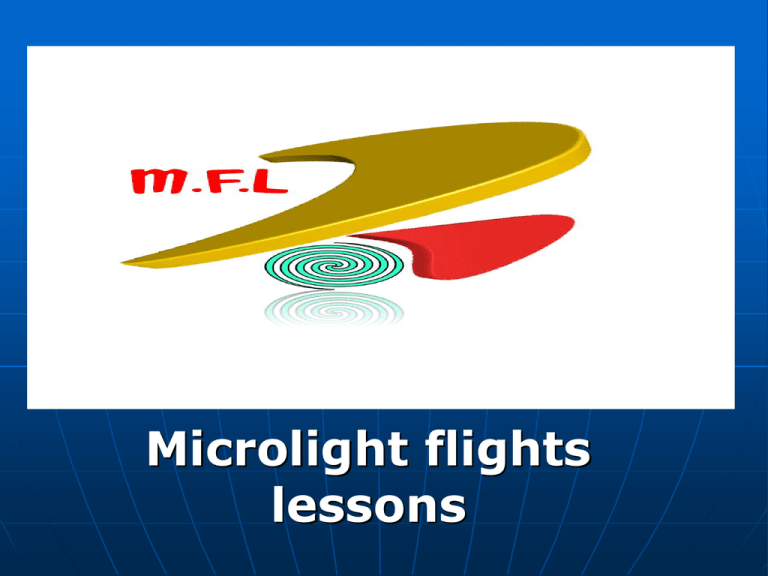
Microlight flights
lessons
Ex 6 Straight & Level
Flight
Aim
To attain and maintain flight in a
straight line and at a constant
altitude
Straight Flight
• To fly straight keep wings laterally level
with the horizon
Reference point
On horizon
Front strut is vertical
In relation to the horizon
Control bar parallel
With horizon
View from trike
Small Heading corrections
• Small Heading corrections can
be made by gently banking
towards the aiming point.
• Then return wing to laterally
level
A Cross wind component
causes drift
Wind
Wind
Nose Into
wind
Basic steady angle
To fly straight towards a crosswind reference point, set up a drift angle
so that the Reference point remains at a steady relative bearing,
alternatively line up to reference points
Control height with power
IF DESCENDING: INCREASE POWER ALLOW NOSE TO RISE
V.S.I
NOTE R.P.M REQUIRED AND NOTE CHANGE OF ATTITUDE
Make only small power changes
IF CLIMBING: REDUCE POWER AND ALLOW NOSE TO RISE
NOTE R.P.M REQUIRED AND NOTE ATTITUDE
V.S.I
When Level and at correct R.P.M
• Maintain correct pitch attitude
• Use small pitch inputs through any
turbulence
Bar forwards to
raise nose
Bar back lower
nose
So power is used to correct any trend of losing or gaining height
Whilst pitch control is used to correct disturbance of pitch attitude
Level Flight At Specific
Airspeeds
• When used individually
• Bar Forward/bar back {Pitch control}
controls airspeed
• Power controls height
• But if pitch only used to increase airspeed
aircraft will also descend
Power only
55mph
60mph
Power and pitch Must be coordinated
Together to increase
Airspeed in level flight
65mph
Power
& Pitch
Pitch only
Level Flight at H.O.T.
Indications of level flight
Correct pitch
attitude
Steady altimeter
reading
Note R.P.M required this will vary with changes in weight,
Atmosphere conditions and airspeed
To Coordinate
To increase airspeed
• P – increase power
• A – attitude bar back to maintain level attitude
• T – trim make small adjustments of power to accurately attain
target airspeed.
To reduce airspeed
• P – reduce power
• A – Attitude bar forwards to maintain level attitude
• T –Trim Make small adjustments of power accurately
attain target airspeed. Trim if within trim speed range
Cruise
Fast
Note that the attitude of the trike unit remains constant if level
Flight is to be maintained irrespective of airspeed
Slow
Airmanship
• Lookout – The clock code
• 12 o’clock is always dead ahead
• Report aircraft relative to the clock code and as above high or low
Enroute Checks : L.I.F.E
L–
I–
F–
E–
location, where are we. Where's the airfield?
Instruments, engine temps and pressures
Fuel, contents how much used?
Elapsed time/endurance
